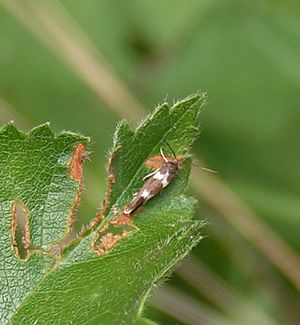Atemelia torquatella facts for kids
Quick facts for kids Atemelia torquatella |
|
|---|---|
 |
|
| Scientific classification | |
| Kingdom: | |
| Phylum: | |
| Class: | |
| Order: | |
| Family: |
Praydidae
|
| Genus: |
Atemelia
|
| Species: |
A. torquatella
|
| Binomial name | |
| Atemelia torquatella (Lienig and Zeller, [1846)])
|
|
The Atemelia torquatella is a type of moth. It belongs to a group of moths called the Praydidae family. Scientists Lienig and Zeller first gave this moth its scientific name in 1846.
Contents
What is a Moth?
Moths are fascinating insects. They are closely related to butterflies. Both moths and butterflies belong to an order of insects called Lepidoptera. This name means "scaly wings." If you look closely, you'll see their wings are covered in tiny, overlapping scales.
Moths vs. Butterflies
It can sometimes be tricky to tell moths and butterflies apart. Here are some simple ways:
- Antennae: Moths often have feathery or straight antennae. Butterflies usually have thin antennae with a club at the end.
- Wings at Rest: When resting, most moths spread their wings flat. Butterflies usually fold their wings upright over their backs.
- Time of Day: Many moths are active at night (nocturnal). Most butterflies fly during the day (diurnal).
- Body Shape: Moths often have thicker, hairier bodies. Butterflies tend to have thinner, smoother bodies.
The Praydidae Family
The Atemelia torquatella moth is part of the Praydidae family. This family includes many small moths. They are often found in different parts of the world. These moths play a role in their ecosystem. They can help pollinate plants. Their caterpillars also eat plant leaves.
Life Cycle of a Moth
Like all moths, the Atemelia torquatella goes through a complete life cycle. This cycle has four main stages:
- Egg: The life cycle starts when a female moth lays tiny eggs. She often places them on a plant.
- Larva (Caterpillar): The eggs hatch into larvae. These are known as caterpillars. Caterpillars spend their time eating and growing. They shed their skin several times as they get bigger.
- Pupa: Once a caterpillar is fully grown, it forms a pupa. For many moths, this stage is inside a cocoon. The cocoon protects the pupa as it transforms.
- Adult Moth: Finally, the adult moth emerges from the pupa. The adult moth's main job is to find a mate and lay eggs. This starts the cycle all over again.
Where Do Moths Live?
Moths live in almost every habitat on Earth. You can find them in forests, grasslands, deserts, and even your backyard! They are found from cold polar regions to hot tropical areas. The specific habitat of the Atemelia torquatella would depend on where the plants it needs to survive grow.

